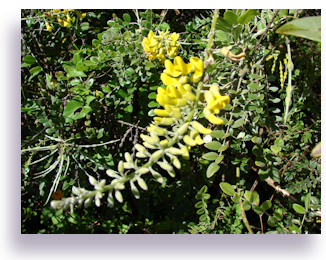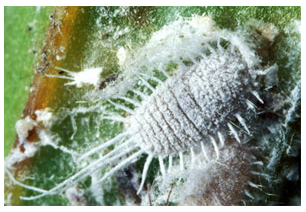Sophora tormentosa
 This shrubby plant, called commonly the Yellow Necklace pod, is often overlooked in native Florida gardens, and yet is indigeninous to this region. The shiny deep green pinnate leaves are similar to cassia, and attract ground bees that occasionally use them for cutting material to line their underground burrows. Yellow Necklace Pod is most known for the long strands of beadlike seed pods, which are yellow and velvet like to the touch. These pods darken as they age and ripen, to a mottled brown.
This shrubby plant, called commonly the Yellow Necklace pod, is often overlooked in native Florida gardens, and yet is indigeninous to this region. The shiny deep green pinnate leaves are similar to cassia, and attract ground bees that occasionally use them for cutting material to line their underground burrows. Yellow Necklace Pod is most known for the long strands of beadlike seed pods, which are yellow and velvet like to the touch. These pods darken as they age and ripen, to a mottled brown.
This plant will spordically flower through most of the year, but is best known for the larger fall blooming period. The lovely yellow flowers are pollinated by bees and butterflies, and then give way to the strands of 'pearls' mentioned above. Flowers are held on long racemes. Able to withstand temperatures as low as 25° without losing their leaves, it remains a thicket of green throughout the winters here in S.W. Florida.
As this fast growing shrub continues to grow, it does produce multiple stems that becomes trunks at the base. This is what creates an eventual thicket, or grove of the plants. and how they multiply.
Fresh seeds are your best bet for propagating in this manner. I had some seeds I gathered right off the mother plant in March, and did not plant until July. They came up sporadically, and some not at all. Next time I am going to sand the seedcoat slightly and see if that speeds up germination. They can also be propagated by semi∼green wood cuttings.
 Since it is a native to Florida, it can handle our sandy soils, but mine do best in one with some well rotted plant material such as the loam created by broken down pine needles and oak leaves. Keep them only slightly moist the first year and a half, and after that they should have established themselves enough to have hit the shallow water table and take care of themselves with our natural rains of summer. However, if droughts threaten, you will need to continue watering to keep it green.
Since it is a native to Florida, it can handle our sandy soils, but mine do best in one with some well rotted plant material such as the loam created by broken down pine needles and oak leaves. Keep them only slightly moist the first year and a half, and after that they should have established themselves enough to have hit the shallow water table and take care of themselves with our natural rains of summer. However, if droughts threaten, you will need to continue watering to keep it green.
Mealybug pests can bring on sooty mildew, which is a blackening appearance to the leaves. Control this with a spray of half water and half rubbing alcohol. Be sure to spray it in early morning, after the dew has lifted and when you expect no rains. These pests are usually found grouped together and create a nasty little cottony nest∼like mess on the tender undersides of your plants, and suck life giving juices out of them.
Here is a great writeup on sophora tomentosa: Lee County extension, Sophora tomentosa var. There are photos of the butterflies and caterpillars that use this plant as a host.
Tags: sophora tormentosa,, sophora tormentosa, yellow necklace pod, mealybug,

